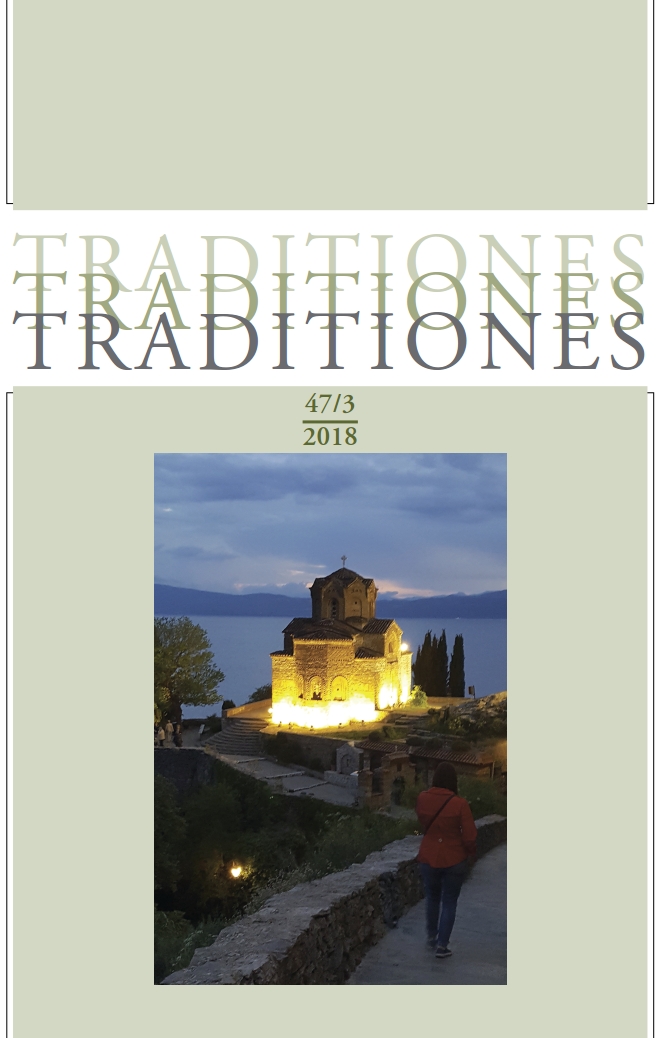The Placeless Chapel: Memory, Meaning and Destruction in Sacred Space
DOI:
https://doi.org/10.3986/Traditio2018470302Keywords:
religious ethnography, place, sacred space, cultural memory, void // etnografija religije, kraj, sveti prostor, kulturni spomin, prazninaAbstract
An ethnographic narrative from Israel, with its sacred sites marked by war and destruction, explores the dynamics of absence and presence, of imagination and reality of religious dwelling places. This idea of a chapel of placelessness underlies an ethnographic field diary written in the summer 2015 in Israel. Sacred spaces offer their presence built on absence, on layers of cultural memory. The focal point of my diary is the town and the sacred sites of Nazareth, built on the incarnation of the word, and, more concretely, on Mary’s house. It is an everyday dwelling place in local narratives, and a centre point of worldwide pilgrimage. Yet, at the same time, the House of Mary is itself imagined as a travelling chapel, absent, but ubiquitously present in innumerable Loreto churches.
***
Etnografska pripoved iz Izraela in njegovih svetih krajev, ki sta jih zaznamovali uničenje in vojna, razgrinja dinamiko o odsotnosti in navzočnosti, o imaginaciji in resničnosti svetih bivanjskih krajev. Zamisli o kapeli brez kraja je podlaga etnografski terenski dnevnik, pisan poleti 2015 v Izraelu. Sveti kraji so ponavzočeni z odsotnostjo, na plasteh kulturnega spomina. Žarišče dnevnika je sveti kraj Nazaret, zgrajen na utelešenju sveta ali, določneje, na Marijini hiši. V lokalnih pripovedih je to vsakdanje bivališče in središčni kraj svetovnega romanja, vendar je Marijina hišica hkrati zamišljena kot potujoča kapela, odsotna, vendar vsepovsodno navzoča v brezštevilnih loretskih cerkvah.
Downloads
References
Appadurai, Arjun. 1998. Modernity at Large: Cultural Dimensions of Globalization. Minneapolis and London: University of Minnesota Press.
Assman, Aleida. 2009. Geschichte findet Stadt. In: Moritz Csáky and Christoph Leitgeb (eds.), Kommunikation – Gedächtnis – Raum. Kulturwissenschaften nach dem „Spatial Turn“. Bielefeld: De Gruyter, 13–27.
Bogdanović, Bogdan. 1994. Architektur der Erinnerung. Klagenfurt: Wieser.
Geertz, Clifford. 1973. Religion As a Cultural System. In: Clifford Geertr, The Interpretation of Cultures. New York: Perseus Books Group, 87–125.
Lachmann, Renate. 2007. Bogdan Bogdanović und seine Zerstörungsphilosophie. In: Davor Beganović and Peter Braun (eds.), Krieg sichten: Zur medialen Darstellung der Kriege in Jugoslawien. Munich: Fink, 105–127.
Lorenzer, Alfred. 1981. Das Konzil der Buchhalter: Die Zerstörung der Sinnlichkeit. Eine Religionskritik. Frankfurt a.M.: Europäische Verlagsanstalt.
Lorenzer, Alfred. 2006. Sprache, Lebenspraxis und szenisches Verstehen in der psychoanalytischen Therapie. In: Alfred Lorenzer, Szenisches Verstehen: Zur Erkenntnis des Unbewußten. Marburg: Tectum (Kulturanalysen; 1), 13–38.
Soeffner, Hans-Georg. 2012. Cosmopolitan Individualization: Twelve Theses on Ulrich Beck. In: Michael Heinlein et al. (eds.), Futures of Modernity: Challenges for Cosmopolitical Thought and Practice. Bielefeld: Transcript, 216–230.
UNESCO. 2015. Director-General Irina Bokova condemns the destruction of the Mar Elian monastery in Syria. UNESCO, August 21. Available at: https://en.unesco.org/news/director-general-irina-bokova-condemns-destruction-mar-elian-monastery-syria
Uspenskij, Boris A. 1992. Semiotik der Geschichte. Wien: Verlag der Österreichischen Akademie der Wissenschaften.
Downloads
Published
How to Cite
Issue
Section
License
Authors guarantee that the work is their own original creation and does not infringe any statutory or common-law copyright or any proprietary right of any third party. In case of claims by third parties, authors commit their self to defend the interests of the publisher, and shall cover any potential costs.
More in: Submission chapter






